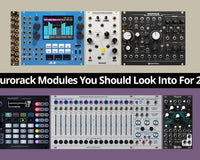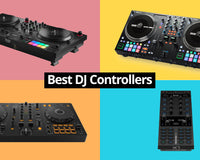An overview of the best compact electronic music gadgets and gizmos to buy, from Teenage Engineering, Korg, Roland, and others.
Anyone who grew up with a Casio keyboard in their home will attest to the joys of portable, battery-powered synths with built-in speakers. In recent years, gear manufacturers have started playing on nostalgia for wonderous gadgets like the VL-1 and SK-1, by releasing compact instruments that sometimes feel like they’re built to be played with rather than played.
Below, we review some of the best portable, battery-powered synths, sequencers, and samplers on the market. We’ll look at products from key innovators like Teenage Engineering as well industry heavy hitters like Korg and Roland. We’ll also look at a couple of less well-known, but no-less-exciting items.
We’ve said it before, and we’ll say it again – making electronic music ought to be fun. And electronic musical instruments ought to be inspiring. These instruments certainly fit the bill. And with the deep functionality they offer, these “toys” demand to be taken seriously. So, let’s get ready to have some serious fun.
The Teenage Engineering OP-1 and Pocket Operator range
Founded in 2005, Sweden’s Teenage Engineering has surely done more than any other company to popularize portable and toy-like gear. It’s flagship product, the OP-1, even resembles a Casio VL-1. In a nice nod to Kraftwerk, it’s Pocket Operators look like (you guessed it) pocket calculators – or hand-held LCD video games from the 80s.
The OP-1 is essentially an extremely compact groove-box. It features a sequencer, synthesizer, and sampler. The LCD screen interface prioritizes technicolour fun, and its battery can run off a single charge for up to 16 hours. But it also includes more esoteric features like a G-force sensor and a variable-speed virtual four-track tape recorder.
It’s easy to see why this extremely stylish instrument has made such an impact on the industry. The OP-1 both inspires and facilitates on-the-go creativity. And because it’s designed to interface with computers and digital audio workstation software, it’s an ideal sketchpad for any musician with an active mind and a busy schedule.
In 2022, TE releases the OP-1 Field, the evolution of the OP–1 synthesizer. Inspired by a decade of technological advancements, ideas and improvements, OP–1 Field features stereo throughout the whole signal chain, bluetooth midi, usb type-c, a new speaker system with a passive driver for detailed, fat and loud sound, a massive 24 hour battery life, multiple tapes and recording formats, new great sounding reverb and the 'dimension' synth engine, an all glass, flush, high resolution display. They also meticulously reworked all graphics, screen by screen as well as FM broadcasting.
While the OP-1 is a sophisticated tool with a relatively pro price point, Teenage Engineering has also applied its design savvy to more accessible musical toys – most notably the Pocket Operator range. These retro-futuristic boxes of delights retail for as little as ≈$120 and represent a sort of gamification of electronic music production.
The Pocket Operators are even more compact than the OP-1 – as the name suggests, one really will fit in your pocket. They’re equally stylish and use a similarly fun-forward LCD interface, where conventional production paradigms are replaced by playful visualizations. They don’t pack as much functionality into a single unit but cover a lot of ground, collectively.
Because the individual units are so small and can easily be chained together and synced, they amount to a kind of modular groove-box system. For instance, you could facilitate some very productive beat-making sessions by linking up the PO-33 KO for sampled drums, the PO-14 Sub for fat basslines, and the PO-16 Factory for lead melodies – all for less than 300 bucks!
If it’s pure play you’re after, Teenage Engineering has taken its gamification strategy to what may be the logical conclusion with the PO-133 Street Fighter.
The Korg Monotron and Volca range
If you’re looking for something portable but find the Pocket Operators too toy-like and the Reface range slightly more than you want to pay, Korg’s products might offer a satisfactory middle ground. Also, Korg offers quite the range of portable options – and the selection just keeps growing!
Korg made a pretty major statement about the possibilities of mini gear with its Monotron range. The Monotron – currently available in two flavours – is surely the world’s smallest ever analogue synthesizer. It’s very much a toy, but it uses some of the same components as Korg’s pro-level analogue gear. The filters in particular sound wonderful.
For Korg minis that you’ll get some serious use out of, the Volca range is the place to look. The Volcas are small and lightweight. They’re not as durable as a touring musician would want and they don’t have proper keyboards or full-sized controls. But you could build a pretty powerful home rig with a miniscule footprint for very little money using just Volcas.
It’s hard to know where to start with the Volca range, but since we were just alluding to Korg’s innovations in FM synthesis, let’s look at the Volca FM 2. This provides a surprisingly powerful synth engine for just over $200 and – as is standard with the Volcas – includes a built-in sequencer and MIDI input.
Where the Volca FM 2 really excels is in usability. Most classic FM synths are notoriously hard to program and effectively impossible to tweak on the go. But the Volca FM 2 includes analogue-style controls that makes key parts of the synthesis process much more intuitive and adjustable in real time.
If the capabilities of the Volca FM are startling, the Volca Keys is perhaps even more remarkable. At the same price point, the Keys offers true analogue synthesis with three-note polyphony. It turns out FM synths don’t have to be hard to use and analogue poly-synths don’t have to be cumbersome and costly. Who knew?
How about modular synthesis? Well, Korg has that covered too, with the Volca Modular. While “Volca Semi-Modular” might be more accurate, this is certainly another iconoclastic little instrument. Into a single Volca unit, it packs eight “modules” (including a randomizer), which can be patched together with tiny pin cables.
Speaking of modular connections, it’s worth noting that all the Volcas have sync in and out jacks that make it simple to synchronize a bunch of units using the same standard eighth-inch mono cables you’d use in Eurorack. And there’s even a Volca Mix for tying it all together and setting a master tempo. 
As mentioned, the Volca range keeps expanding – most recently to include the Volca Sample 2. As the name suggests, this is a surprisingly full-featured beat-making sampler with a range of analogue-style controls to make on-the-fly slicing and dicing easy and fun. Arguably, there’s something for everyone in the Volca range.
But the Volcas may not be for everyone. While we introduced them as a happy medium between the Pocket Operators’ playfulness and Refaces’ pro quality, it may be that these Korgs sometimes fall between two stools – not fun enough for some folks, too flimsy for others. However, there are plenty of users out there who find these little units to be both cool and practical.
Roland Boutique
If you’re looking for a more pro alternative to the Volca range, Roland’s Boutique line might fit the bill. These recreations of classic synths and drum machines certainly fit the profile of the instruments we’re discussing here as they’re very compact, can be powered by batteries, and have built-in speakers.
One of the nicest aspects of the Boutique range is that, while all the units come as desktop modules, there’s also the highly affordable K-25M Portable Keyboard, which Boutique synths seamlessly slot into. With this keyboard in the mix, these synths are also worth considering as alternatives to the Reface range. 
The Boutique line offers more variety than the Refaces, though – certainly rivaling the Volcas in that regard. Like the Refaces, this series tends toward digital recreations of classic gear – rather than offering miniaturized versions of true analogue technology. And for live electronic music tweaking, Roland offers some very tempting portable options.
The SH-01A is a particularly exciting little synth, as it’s a polyphonic recreation of the SH-101 – one of those cultish instruments that was a commercial failure at the time but has had a long afterlife. The SH-101 was actually one of the first synths to be available as a keytar. Sadly, Roland loses fun points here as it seems to have no plans to release the SH-01A in this format. 
The SH-101 may have had a long, healthy afterlife but it pales in comparison to eternal relevance of the TB-303 – the “acid box”, heard on about a billion techno tracks over the years. The TB-03 is a faithful (albeit digital) recreation of that legendary bassline synthesizer. A highly desirable synth as it’s hard to imagine a more iconic piece of gear than the 303.
And if we had to pick one, it would be the TR-808 drum machine, a staple of hip-hop and dance music for literally decades. Naturally, Roland has added a recreation of the 808 to its Boutique line – the TR-08. Link this up with the TB-03 and SH-01A and you’ll be in retro club music heaven before you know it. 
Roland’s new SP-404MKII sampler has caused quite a stir among electronic music producers and gear aficionados. In the age of endlessly powerful music software and impressively feature-packed grooveboxes, the arrival of a new phrase sampler might seem like no big deal. Still, folks with a deep passion for music gear seem seriously fired up about this release.
In terms of portability, the MKII is impressively lightweight and durable. Its desktop footprint is about 28 by 18 centimeters (11 by 7 inches). Also, despite its tough metal enclosure, the whole unit only weighs just over one kilogram (or about two-and-a-half pounds). This is a sampler you can carry around in your backpack, no problem. 
Other Manufacturers
While Teenage Engineering, Korg, and Roland are the big names in this field, they’re not alone. The popularity of the Pocket Operators and Volcas, in particular, has led some other manufacturers to dip their toes into the mini-synth market. Maybe Casio will even be tempted to come up with a turbo-charged reboot of the VL-1 or the SK-1.
For now, Casio fans may have to settle for the Alesis Harmony 32, which has the charm of a little Casio but with contemporary features and Alesis build quality. It also includes educational features, which make it an ideal first synth for kids of all ages who are learning to play keyboards. And yes, it is battery powered, with built-in speakers.
For those interested in alternatives to the Volca Keys, the Modal Electronics Skulptsynth SE is worth a look. While this is an analogue-modelling poly-synth, rather than a true analogue synthesizer, it does beat the Volca Keys by offering four-note polyphony. It also packs quite the range of modulation options into a tiny package.
Smaller companies like Modal getting into this market is exciting because it raises the likelihood of innovation. The instruments offered by Korg and Roland are excellent but none of them beat the Swedish upstarts at Teenage Engineering for paradigm-shifting imaginativeness and sheer joyfulness.
There’s plenty of playful inspiration to be had with these mini wonders of technological and musical ingenuity – and you can bet there’s much more on the way.









